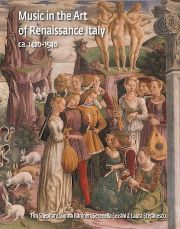Ancient artifacts and Renaissance iconography
Three magnificent recent publications tackle themes of growing interest: the study of the dialogue between music and the other arts, particularly the visual arts, the exploration of musical practice in ancient civilizations, and research into organological archaeology.

The visual arts of Quattrocento Italy and the first half of the Cinquecento readily depicted musicians, whether in religious settings (angel musicians, King David) or on secular subjects - country concerts, portraits, ensembles of instrumentalists or singers, references to the mythology of classical antiquity (Apollo and the Muses, Orpheus, Bacchanalia of the Maenads). Enhanced by 230 illustrations, this invaluable work published in English by Harvey Miller Publishers, a publishing house renowned for the quality of its art books, was written by an interdisciplinary team under the direction of Tim Shephard, highlighting the rich variety of interactions between the arts of hearing and the eyes. The text explores the themes addressed in greater depth, drawing on both Renaissance theoretical writings and iconography, and extending the analysis to the social and intellectual situations of the time.
Musical practice in Antiquity
An exceptional exhibition at the Musée du Louvre-Lens (Pas-de-Calais) in 2017 put into perspective the ubiquitous practice of music in everyday life in Mesopotamian, Egyptian, Greek and Roman antiquity. Its remarkable catalog, published by Snoeck and featuring almost 500 color reproductions, sheds light on its many aspects with equal parts pedagogy and erudition, updating knowledge in fast-developing research fields such as musical archaeology, sound anthropology and the study of ancient lutherie. Thanks to incessant contacts and exchanges between civilizations, particularly around the Mediterranean, reciprocal influences were woven, while practices and modes of expression varied greatly. Part of the book is devoted to summary articles, with interspersed notes on Mesopotamian musical theory, for example, or on the discovery of pictorial representations and instruments in Pompeii, while the main body of the book describes the context of the artifacts in the exhibition in terms of cross-civilizational themes (music for divine worship or for the court, status of musicians, organology, etc.). The appendices also provide an overview of the contribution of new technologies to our knowledge of the sounds of the past.
Curved trumpets from Pompeii
Three of the many authors of the previous book, as well as one of the subjects mentioned, can be found in a booklet published by Presses universitaires de Rennes, dedicated to the five cornua unearthed at Pompeii in the 19th century. These curved bronze trumpets, with their ideal phonic power for military signals, amphitheatres (particularly for gladiatorial fights) or solemn processions, but also for funeral bells or summonses to the assembly, could be played alone, in pairs, in duet with the hydraule or tuba (a kind of upright trumpet), or in ensembles. In addition to the social uses of the cornu and their iconography, this abundantly illustrated monograph (60 figures and a large color hors-texte) looks more specifically at the discoveries and restorations of Pompeian examples, their instrumental manufacture, the modern copies that have been made, as well as their museographic enhancement or acoustic study with a view to sound restitution.
Tim Shephard, Sanna Raninen, Serenella Sessini, Laura Stefanescu: Music in the Art of Renaissance Italy, 1420-1540, IV+408 p., € 140.00, Harvey Miller Publishers/Brepols, Turnhout 2020, ISBN 978-1-912554-02-7
Music! Echoes of antiquity, Sybille Emerit, Hélène Guichard, Violaine Jeammet, Sylvain Perrot, Ariane Thomas, Christophe Vendries, Alexandre Vincent, Nele Ziegler, 400 p.,
€ 39.00, Snoeck Publishers, Gent 2017, ISBN 9789461614179
Cornua de Pompéi - Trompettes romaines de la gladiature, edited by Christophe Vendries, 124 p., € 32.00, Presses Universitaires de Rennes PUR, 2020,
ISBN 978-2-7535-7895-1











